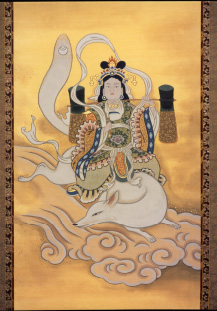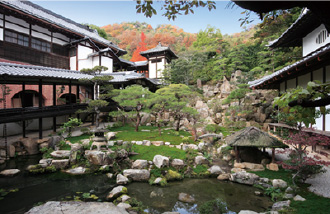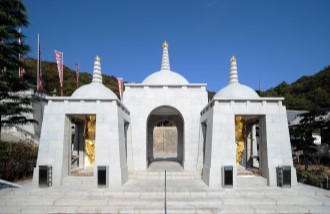Saijo Inari (Saijo Inari-san Myokyoji Temple)
A symbol of the Japanese spirit and culture for more than 1200 years, Saijo Inari Temple continues to attract people from all over the country even today.

Kibi Plain known as the setting for Japan’s most famous folk tale, “The Legend of Momotaro,” features a number of burial mounds created more than 1500 years earlier. Saijo Inari and its enormous O-torii(the gate at the temple's entrance) standing 27 meters tall, situated on the mountainside overlooking the plain, offers one of the most eye-catching views found in this lush countryside.
The official name of the temple is Saijo Inari-san Myokyo-ji. Because torii are symbols of shinto shrines, the torii at Saijo Inari makes this temple a rare example of the religions of ancient Japan. Every year about 3 million people visit this temple, where “Saijoi Kyo-o Daibosatsu,” believed responsible for prosperity in business and good harvests, is worshipped.
Saijo Inari, boasting a history stretching back more than 1200 years, is an Inari temple devoted to protecting the Lotus Sutra and the teachings of Buddhism.
It is known as one of three major Inari in Japan along with Fushimi-Inari Taisha and Toyokawa Inari Temple.
Legend has it that the well-trained priest Ho-on Daishi had a vision of Saijoi Kyo-o Daibosatsu (known affectionately as “Saijo Sama”), the principal image, and became enlightened in 752 while worshipping at the stone outcropping known as Hachijoiwa. After this vision, Ho-on Daishi built a temple near the site in 785 and named it "Ryuozan Jinguji." After flourishing for hundreds of years as a venerable temple, the buildings were unfortunately lost due to damage sustained during the civil war in the late 16th century.
However, the temple was rebuilt in 1601 by the priest Nichien Shonin, who was visiting from the Kanto region (near modern-day Tokyo), and the temple was renamed Saijo Inari-san Myokyoji. Since then, the temple has been revered by many people as “Saijo Sama, bringer of mysterious divine favor.”
Within the temple grounds stand the former main hall, Kyu-Honden, and the historic wooden building known as Konpon-daido(memorial service hall). In addition, during hatsumode (the new year's first temple visit to pray for luck), large numbers of people visit the temple to pray for peace and happiness in the coming year.
Inside the Temple

O-Torii Gate(Great Gate)
One of the symbols of Saijo Inari Temple, this torii stands 27.5 meters tall with pillars boasting diameters of 4.6 meters and weighs 2,800 tonnes all together, making it one of Japan’s largest. In 2014, the torii was repainted in the traditional red ocher color pigment (Bengara) used since ancient times. The parking at the base of the torii allows visitors to drive right up to the torii for a closer look.

Honden (Main Hall)
Visited annually by some 3 million worshippers and visitors, the Honden(Main Hall) stands as the temple’s representative building. The voices of priest chanting can sometimes be heard coming from within this huge, solemn building, filling the air with an aura of sacredness.

Kansho-tei Garden(Temple Garden)
Invoking the style of Japanese gardens from 500 years ago, this garden is characterized by its exciting arrangement of stones. The garden’s sacred stone stands highest in the garden against a backdrop of pine trees. The withered waterfall in front of this stone is said to flow with the mercy of the Bosatsu and nourish the pond below, which serves as a gathering place.

Niomon Gate
Built in the architectural style of India, this stone gate is a rare specimen and has been recognized as a Registered Tangible Cultural Property by the Japanese
Government agency. The powerful golden images enshrined within the gate are known as the “Nio.” Renovated in 2013, the bright white of the new stone gate offers a striking contrast to the golden images within, welcoming visitors in spectacular fashion.

Kyu-Honden (Former Main Hall)
Among the four wooden buildings that comprise Kyu-Honden, the innermost building is the oldest, having been built in 1741. The building's hiwada buki (cypress bark thatched roofing) and the delicately sculpted pillars are just two examples of traditional aspects found in the wooden structures of Japan. Within Kyu-Honden, the thirty guardian deities known as “Sanjubanshin” are worshipped.
*"Sanjuban shin" is a synchronism of Shinto and Buddhism, with 30 deities taking turns every day guarding the nation and the people.
Temple
Access to Saijo Inari
712 Takamatsuinari, Kita Ward, Okayama City,
Okayama Prefecture 701-1331
Tel: 086-287-3700 / Fax: 086-287-3709
Hours
24-hour admittance (Open year-round)
*Reception desk and shop: 9:00am 〜 4:30pm
Admission
Free
*Admission is free with the exception of some facilities (such as Kansho-tei Garden(Temple Garden)).
Kansho-tei Garden(Temple Garden):
Hours: 9:30am 〜 3:00pm
Admission: General 300 yen; students and groups 200 yen; elementary school students and younger free

